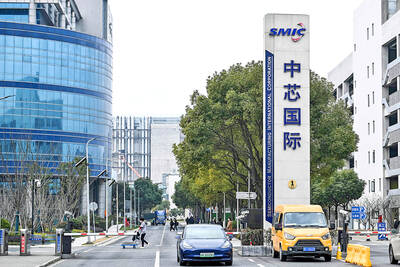Brigitte Bardot lounged barefoot on a Saint-Tropez beach, drawing languorous puffs from her cigarette. Another actor, Jean-Paul Belmondo, swaggered down the Champs-Elysees with smoke curling from his defiant lips, capturing a generation’s restless rebellion.
In France, cigarettes were never just cigarettes — they were cinematic statements, flirtations and rebellions wrapped in rolling paper.
Yet beginning July 1, if Bardot and Belmondo’s iconic film scenes were repeated in real life, they would be subject to up to 135 euros (US$153) in fines.

Photo: AP
After glamorizing tobacco for decades, France is preparing for its most sweeping smoking ban yet. The new restrictions, announced by French Minister of Labor, Health, Solidarity and Families Catherine Vautrin, would outlaw smoking in virtually all outdoor public areas where children may gather, including beaches, parks, gardens, playgrounds, sports venues, school entrances and bus stops.
“Tobacco must disappear where there are children,” Vautrin told French media. The freedom to smoke “stops where children’s right to breathe clean air starts.”
If Vautrin’s law reflects public health priorities, it also signals a deeper cultural shift. Smoking has defined identity, fashion and cinema here for so long that the new measure feels like a quiet French revolution in a country whose relationship with tobacco is famously complex.
According to France’s League Against Cancer, more than 90 percent of French films from 2015 to 2019 featured smoking scenes — more than double the rate in Hollywood productions. Each French movie averaged nearly three minutes of on-screen smoking, effectively the same exposure as six 30-second television ads.
Cinema has been particularly influential. Belmondo’s rebellious smoker in Jean-Luc Godard ’s Breathless became shorthand for youthful defiance worldwide. Bardot’s cigarette smoke wafted through And God Created Woman, symbolizing unbridled sensuality.
Yet this glamorization has consequences. According to France’s public health authorities, about 75,000 people die from tobacco-related illnesses each year. Although smoking rates have dipped recently — fewer than 25 percent of French adults now smoke daily, a historic low — the habit remains stubbornly embedded, especially among young people and the urban chic.
France’s relationship with tobacco has long been fraught with contradiction. Air France did not ban smoking on all its flights until 2000, years after major US carriers began phasing it out in the late 1980s and early 1990s. The delay reflected a country slower to sever its cultural romance with cigarettes, even at 35,000 feet.
Strolling through the stylish streets of Le Marais, the trendiest neighborhood in Paris, reactions to the smoking ban ranged from pragmatic acceptance to nostalgic defiance.
“It’s about time. I don’t want my kids growing up thinking smoke is romantic,” said Clemence Laurent, a 34-year-old fashion buyer, sipping espresso at a crowded cafe terrace. “Sure, Bardot made cigarettes seem glamorous, but Bardot didn’t worry about today’s warnings on lung cancer.”
At a nearby boutique, vintage dealer Luc Baudry, 53, saw the ban as an attack on something essentially French.
“Smoking has always been part of our culture. Take away cigarettes and what do we have left? Kale smoothies?” he scoffed.
Across from him, 72-year-old Jeanne Levy chuckled throatily, her voice deeply etched — she said — by decades of Gauloises.
“I smoked my first cigarette watching Jeanne Moreau,” she said, eyes twinkling behind vintage sunglasses. “It was her voice — smoky, sexy, lived-in. Who didn’t want that voice?”
Jeanne Moreau’s gravelly, nicotine-scraped voice transformed tobacco into poetry itself, immortalized in classics such as Francois Truffaut’s Jules et Jim. Smoking acquired an existential glamour that made quitting unimaginable for generations of French smokers.
France’s new law mirrors broader European trends. The UK, Spain and Sweden have all implemented significant smoking bans in public spaces.
In the Paris park Place des Vosges, literature student Thomas Bouchard clutched an electronic cigarette that is still exempt from the new ban and shrugged.
“Maybe vaping’s our compromise,” he said, exhaling gently. “A little less sexy, perhaps. But fewer wrinkles too.”

SEMICONDUCTOR SERVICES: A company executive said that Taiwanese firms must think about how to participate in global supply chains and lift their competitiveness Taiwan Semiconductor Manufacturing Co (TSMC, 台積電) yesterday said it expects to launch its first multifunctional service center in Pingtung County in the middle of 2027, in a bid to foster a resilient high-tech facility construction ecosystem. TSMC broached the idea of creating a center two or three years ago when it started building new manufacturing capacity in the US and Japan, the company said. The center, dubbed an “ecosystem park,” would assist local manufacturing facility construction partners to upgrade their capabilities and secure more deals from other global chipmakers such as Intel Corp, Micron Technology Inc and Infineon Technologies AG, TSMC said. It

NO BREAKTHROUGH? More substantial ‘deliverables,’ such as tariff reductions, would likely be saved for a meeting between Trump and Xi later this year, a trade expert said China launched two probes targeting the US semiconductor sector on Saturday ahead of talks between the two nations in Spain this week on trade, national security and the ownership of social media platform TikTok. China’s Ministry of Commerce announced an anti-dumping investigation into certain analog integrated circuits (ICs) imported from the US. The investigation is to target some commodity interface ICs and gate driver ICs, which are commonly made by US companies such as Texas Instruments Inc and ON Semiconductor Corp. The ministry also announced an anti-discrimination probe into US measures against China’s chip sector. US measures such as export curbs and tariffs

The US on Friday penalized two Chinese firms that acquired US chipmaking equipment for China’s top chipmaker, Semiconductor Manufacturing International Corp (SMIC, 中芯國際), including them among 32 entities that were added to the US Department of Commerce’s restricted trade list, a US government posting showed. Twenty-three of the 32 are in China. GMC Semiconductor Technology (Wuxi) Co (吉姆西半導體科技) and Jicun Semiconductor Technology (Shanghai) Co (吉存半導體科技) were placed on the list, formally known as the Entity List, for acquiring equipment for SMIC Northern Integrated Circuit Manufacturing (Beijing) Corp (中芯北方積體電路) and Semiconductor Manufacturing International (Beijing) Corp (中芯北京), the US Federal Register posting said. The

India’s ban of online money-based games could drive addicts to unregulated apps and offshore platforms that pose new financial and social risks, fantasy-sports gaming experts say. Indian Prime Minister Narendra Modi’s government banned real-money online games late last month, citing financial losses and addiction, leading to a shutdown of many apps offering paid fantasy cricket, rummy and poker games. “Many will move to offshore platforms, because of the addictive nature — they will find alternate means to get that dopamine hit,” said Viren Hemrajani, a Mumbai-based fantasy cricket analyst. “It [also] leads to fraud and scams, because everything is now